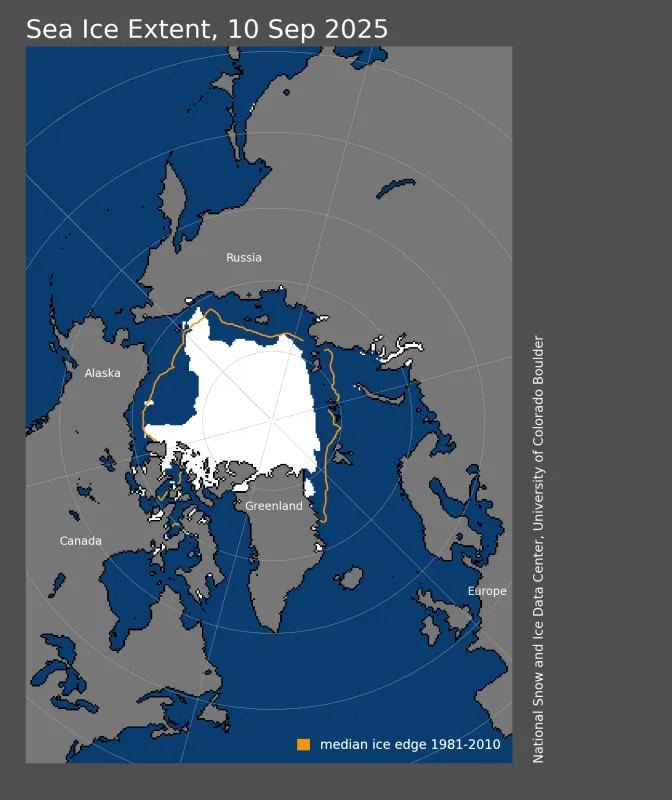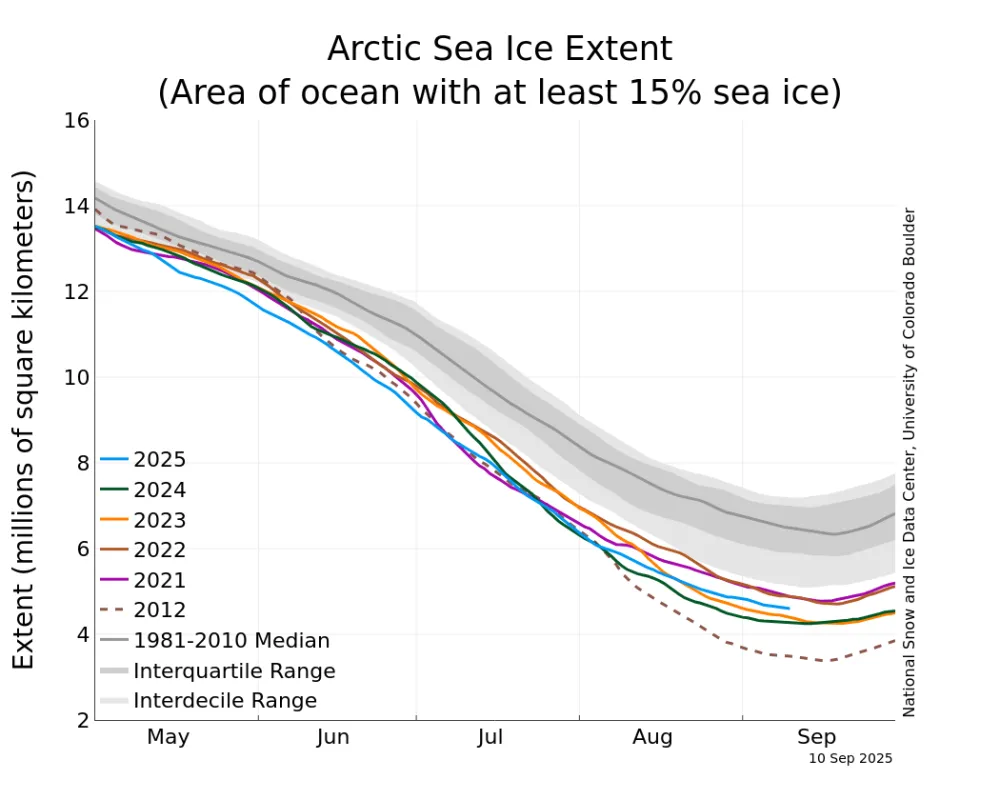On September 10, Arctic sea ice likely reached its annual minimum extent of 4.60 million square kilometers (1.78 million square miles). The 2025 minimum shares the tenth lowest spot in the nearly 47-year satellite record with 2008 and 2010. While the last 19 years, from 2007 to 2025, are the lowest 19 sea ice extents in the satellite record, there has been no significant trend in September minimum extents over this time. As announced earlier, the minimum is based on Advanced Microwave Scanning Radiometer 2 (AMSR2) data from the Japan Aerospace Exploration Agency (JAXA).
In the Antarctic, sea ice extent has been tracking at the third lowest level in the satellite record for most of the growth season, but the maximum has not yet been reached. Large fluctuations in extent are typical of Antarctic sea ice near the seasonal maximum, often leading to some delay in confidently identifying the maximum, which typically occurs in late September or early October but has been reached as early as August 30.
Note that this is a preliminary announcement. Changing winds or late-season melt could still reduce the Arctic ice extent, as happened in 2005 and 2010. NSIDC scientists will release a full analysis of the Arctic melt season, and discuss the Antarctic winter sea ice growth, in early October.
Overview of conditions
On September 10, Arctic sea ice has likely reached its annual minimum extent of 4.60 million square kilometers (1.78 million square miles) (Figure 1a). As the sun dips below the Arctic horizon, falling air temperatures promote the expansion of ice extent throughout the growth season. However, with significant patches of low ice concentration still remaining, a late-season storm could compress the sea ice and push the ice extent even lower.
If September 10 holds as the minimum date, the 2025 minimum extent was reached four days earlier than the 1981 to 2010 median minimum date of September 14. The interquartile range of minimum dates is September 11 to September 19.
Figure 1a. Arctic sea ice extent for September 10, 2025, was 4.60 million square kilometers (1.78 million square miles). The orange line shows the 1981 to 2010 average extent for that day. Sea Ice Index data. About the data — Credit: National Snow and Ice Data Center
Figure 1b. The graph above shows Arctic sea ice extent as of September 10, 2025, along with daily ice extent data for four previous years and the record low year. 2025 is shown in blue, 2024 in green, 2023 in orange, 2022 in brown, 2021 in magenta, and 2012 in dashed brown. The 1981 to 2010 median is in dark gray. The gray areas around the median line show the interquartile and interdecile ranges of the data. Sea Ice Index data. — Credit: National Snow and Ice Data Center
Conditions in context
This year’s minimum extent, based on a 5-day average, appears to have been set on September 10. It is 1.21 million square kilometers (467,000 square miles) above the satellite-era record minimum extent of 3.39 million square kilometers (1.31 million square miles), which occurred on September 17, 2012 (Figure 1b). It is also 1.62 million square kilometers (625,000 square miles) below the 1981 to 2010 average minimum extent, which is equivalent to about the loss in size of Alaska.
In the 47-year-satellite record, the 19 lowest minimums have all occurred in the last 19 years.
The overall, downward trend in the minimum extent from 1979 to 2025 is 12.1 percent per decade relative to the 1981 to 2010 average. From the linear trend, the loss of sea ice is about 74,000 square kilometers (29,000 square miles) per year, equivalent to losing the state of South Dakota or the country of Austria annually.
This overall trend should be viewed with the caveat that there has been no significant downward trend in September minimum extents over the past two decades. Causes for this flattening trend are a matter of active debate in the Arctic science community. However, all years after 2006, from 2007 to 2025, have still had a lower minimum extent than all the previous years in the record from 1979 to 2006.
| RANK | YEAR | MINIMUM ICE EXTENT | DATE | |
|---|---|---|---|---|
| IN MILLIONS OF SQUARE KILOMETERS | IN MILLIONS OF SQUARE MILES | |||
| 1 | 2012 | 3.39 | 1.31 | Sept. 17 |
| 2 | 2020 | 3.82 | 1.47 | Sept. 16 |
| 3 | 2007 2016 2019 | 4.16 4.17 4.19 | 1.61 1.61 1.62 | Sept. 18 Sept. 10 Sept. 18 |
| 6 | 2024* 2023* | 4.25 4.26 | 1.64 1.64 | Sept. 13 Sept. 19 |
| 8 | 2011 | 4.34 | 1.68 | Sept. 11 |
| 9 | 2015 | 4.43 | 1.71 | Sept. 9 |
| 10 | 2008 2025 2010 | 4.59 4.60 4.62 | 1.77 1.78 1.78 | Sept. 19 Sept. 10 Sept. 21 |
Values within 40,000 square kilometers (15,000 square miles) are considered tied.
*The 2023 and 2024 values have changed when final analysis data updated near-real-time data. The 2023 extent changed from 4.23 to 4.26 million square kilometers (1.63 to 1.64 million square miles). The 2024 extent changed from 4.28 to 4.25 million square kilometers (1.65 to 1.64 million square miles) and the date of the minimum moved from September 11 to September 13.

